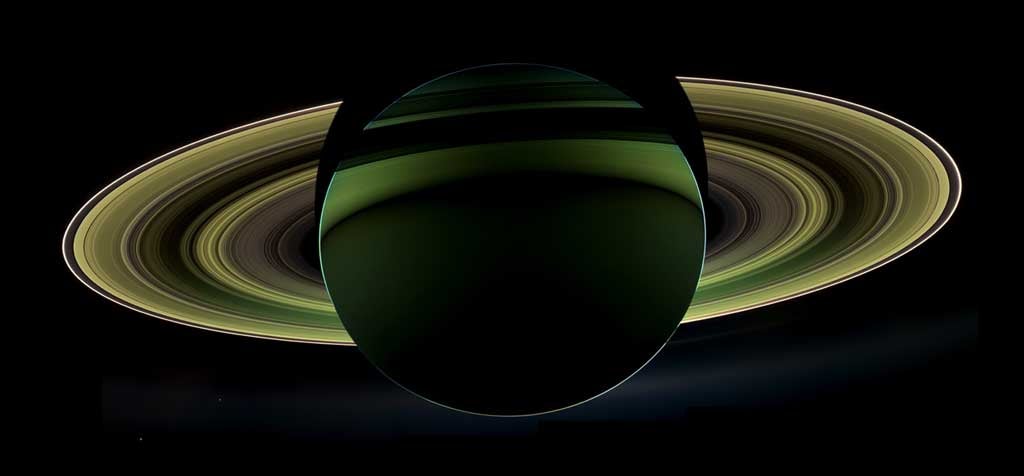March evenings offer an excellent chance to see the zodiacal light. From the Northern Hemisphere, late winter and early spring are great times to observe this elusive glow after sunset. It appears slightly fainter than the Milky Way, so you’ll need a clear moonless sky and an observing site located far from the city. With the waning crescent Moon now strictly a morning object, this is the time to seek out the light (excellent conditions continue through March 18). Look for the cone-shaped glow, which has a broad base and points nearly straight up from the western horizon, after the last vestiges of twilight have faded away.
Saturday, March 10
The waning crescent Moon appears equidistant between Mars and Saturn this morning. The trio rises by 3 a.m. local time and looks stunning in the south-southeast as twilight starts to paint the sky. The two planets shine almost equally bright but are easy to tell apart because Mars looks distinctly ruddy while Saturn glows with a yellow hue. When viewed through a telescope, however, Saturn is the clear winner. It sports a disk that measures 16″ across and a stunning ring system that spans 37″ and tilts 26° to our line of sight. Mars has an apparent diameter of only 7″ and shows little, if any, detail.
For most people in the United States and Canada, daylight saving time begins at 2 a.m. local time this morning. Set your clocks ahead one hour.
The Moon reaches apogee, the farthest point in its orbit around Earth, at 5:14 a.m. EDT. It then lies 251,455 miles (404,678 kilometers) from Earth’s center.
Monday, March 12
Mars’ eastward motion relative to the background stars carries it from Ophiuchus into Sagittarius today. The magnitude 0.6 Red Planet rises around 3 a.m. local daylight time and climbs some 25° high in the south-southeast by the time twilight begins. Although the passage from Ophiuchus into Sagittarius is little more than a technical milestone, it does set up a series of pretty conjunctions with some of the Archer’s deep-sky gems starting next week.
Tuesday, March 13
Head outside before dawn and you can’t miss Jupiter. The giant planet rises around midnight local daylight time and climbs highest in the south around 5 a.m. Jupiter shines at magnitude –2.2, which makes it the brightest point of light in the predawn sky, and resides among the much dimmer stars of the constellation Libra. A telescope reveals the planet’s 40″-diameter disk and plenty of detail in the gas giant’s cloud tops.
Wednesday, March 14
As midnight approaches, look to the east for the bright star Arcturus. At magnitude 0.0, it is the second-brightest star visible from mid-northern latitudes. If you look about 20° to the left and a little below this luminary, you should see a conspicuous semicircle of stars — the constellation Corona Borealis the Northern Crown. It’s the most prominent group of stars having a shape reminiscent of a circle, and it makes a fitting target for Pi Day. (For you non-geeks, Pi Day is 3/14 because the first three digits of the mathematical constant pi are 3.14. Pi is the ratio of a circle’s circumference to its diameter, so today we celebrate all things circular.)
For those of you in the Southern Hemisphere, today marks the peak of the annual Gamma Normid meteor shower. The shower’s radiant — the point from which the meteors appear to originate — lies among the background stars of the southern constellation Norma the Square. This region lies below the horizon for observers north of 40° north latitude, but those farther south should keep their eyes open. The best views will come after midnight, once the radiant climbs higher. Fortunately, the waning crescent Moon sheds little light into the predawn sky. The shower typically produces about 6 meteors per hour at its peak.
Thursday, March 15
Mercury reaches greatest elongation at 11 a.m. EDT, and tonight marks the peak of its best evening apparition of 2018 for Northern Hemisphere observers. The innermost planet lies 18° east of the Sun and stands 12° high in the west a half-hour after sunset. It shines at magnitude –0.4 and shows up well against the darkening sky. But the easiest way to find it is to locate brilliant Venus and then look 4° to the upper right. The two inner planets fit nicely in a single binocular field of view. A view of Mercury through a telescope reveals an 7″-diameter disk that appears slightly less than half-lit. (Venus spans 10″ and is nearly full.)
One of the sky’s largest asterisms — a recognizable pattern of stars separate from a constellation’s form — occupies center stage after darkness falls on March evenings. To trace the so-called Winter Hexagon, start with southern Orion’s luminary, Rigel. From there, the hexagon makes a clockwise loop. The second stop is brilliant Sirius in Canis Major. Next, pick up Procyon in the faint constellation Canis Minor, then the twins Castor and Pollux in Gemini, followed by Capella in Auriga, Aldebaran in Taurus, and finally back to Rigel.
Saturday, March 17
New Moon occurs at 9:12 a.m. EDT. At its New phase, the Moon crosses the sky with the Sun and so remains hidden in our star’s glare.
Mercury and Venus have their second close conjunction of March this evening. Innermost Mercury passes 4° due north (upper right) of its neighbor at 9 p.m. EDT.
Sunday, March 18
With an age of 4.5 billion years, “young” might not seem an appropriate word to describe our Moon. But tonight, you have an exceptional opportunity to see what astronomers call a “young Moon” — a slender crescent visible in the early evening sky. With New Moon having occurred yesterday morning, only 2 percent of our satellite’s disk appears illuminated after sunset tonight. It forms a spectacular trio with Venus 4° to its right and Mercury 4° farther away. You should notice an ashen light faintly illuminating the Moon’s dark side. This is “earthshine,” sunlight reflected by Earth that reaches the Moon and then reflects back to our waiting eyes.












